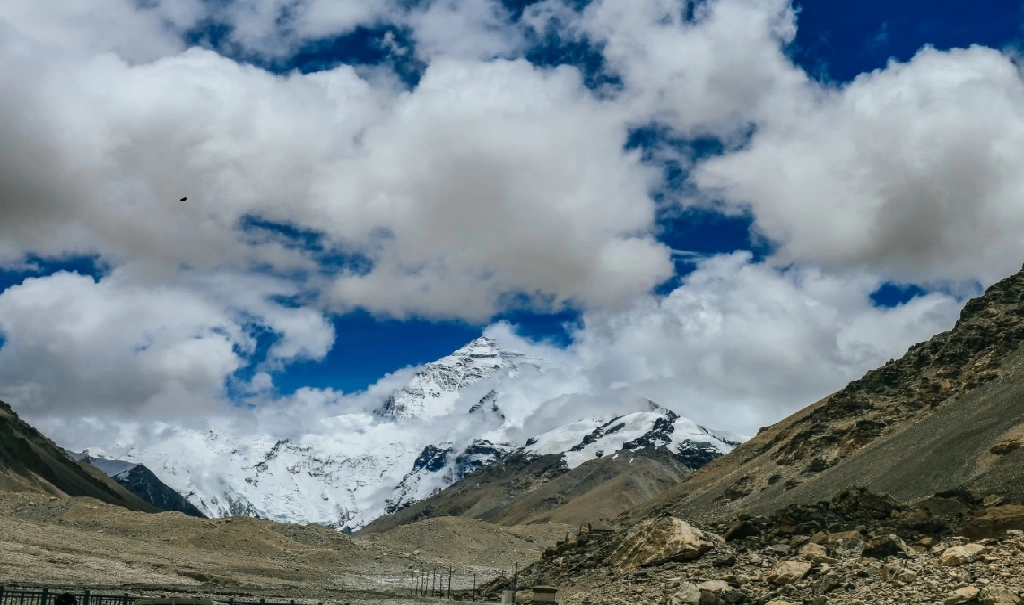Everest Expedition in Spring (March, May, April) takes you to the peak of the tallest mountain in the world, i.e., Everest, at 8,849 m. Suppose You've always dreamed of standing on top of the world. Now's your chance to realize that dream with our Everest Expedition in Spring package.
Above all the peaks of the Himalayas, Mount Everest stands dominant at 8848.48 m (29,030 ft) as the true King of all peaks. This famous mountain is situated on the borderline between Nepal and Tibet. It is highly regarded by the Nepalese and Sherpas, who worship it as 'Sagarmatha,' and the Tibetans, who revere it as 'Chomolungma.'
Mount Everest Climbing in Spring Itinerary takes you from Kathmandu to Base Camp and guides you every step up the tallest mountain on Earth. Our experienced Sherpas have summited Everest countless times before - you can trust them to get you up and down safely, which is all-inclusive in the Everest Expedition package.
Since the first British expedition in 1921, Mount Everest has always invited adventurers from across the globe, calling them to test their mettle and attempt to reach lofty peaks. Finally, on May 29, 1953, Tenzing Norgay Sherpa of Nepal and Sir Edmund Hillary did the impossible and mounted the first successful ascent to the summit. With the Everest Climbing Spring package, you follow their footsteps and reach the peak of the tallest peak.
With Everest Expedition in Spring Package, You'll join the elite few who have experienced the exhilaration of summiting Mount Everest. Trek across crevasse-filled glaciers, climb near vertical faces and push yourself to the limit. The air will be thin, but the views will be astounding. Don't let this opportunity pass you by. Reserve your spot today for 2024, 2025, and 2026 with the Mt Everest Expedition in Spring package and start the adventure of a lifetime.
Our Everest expedition in spring Itinerary consists of a thrilling 65-day journey to the top of the world. After arriving in Kathmandu, you'll fly to Lukla to follow the Everest Base Camp trek route. Along the way, you'll pass through charming Sherpa villages, walk through Sagarmatha National Park, a UNESCO World Heritage site, and view the Himalayan peaks like Ama Dablam and Lhotse.
Once you reach the Everest Base Camp, our expert Sherpa guides will help you acclimatize to the high altitude for a few days as per the Everest expedition Itinerary. Then, you'll go through the treacherous Khumbu Icefall and up the Lhotse Face to Camp 2. After a rest day, follow up the Everest expedition route and continue to Camp 3 in the "Yellow Band," a distinctive yellow limestone cliff. Two more camps and you'll finally reach the South Col and prepare for the final ascent.
With the Everest expedition in spring, The thrill of scaling massive cliffs and walls, reaching the top, and enjoying the breathtaking views draws many climbers to Nepal. The stunning scenery amid the snow-capped Himalayas provides the perfect backdrop for an unforgettable climbing experience. The physical and mental challenges required on the Everest expedition pushed you outside your comfort zone and built confidence in yourself and your abilities.
For the Mountaineers interested in the Everest Climbing Expedition in spring 2024, 2025, and 2026, now is your chance to book. Adventure altitude treks now offer the Everest climbing spring package at a discount cost. It's best to join the Everest expedition in the group as we offer group discounts for the 2024, 2025, and 2026 spring packages. Contact us and Book this Everest expedition spring package now and reach the top of Everest with our experienced sherpa guide team.
Everest Expedition in Spring Cost 2024, 2025, and 2026 packages are still on. Book early and benefit from group discounts.
Major Highlights of the Everest Expedition In Spring
- Conquer the world's highest mountain, which reaches 8848 m above sea level.
- Stand on top of the world and see the breathtaking snow-capped Himalayan range.
- Best Everest Expedition In Spring package at discount cost 2024, 2025, and 2026.
- Hike across the mystical Everest region, where Mother Nature has fully shown her magnificence.
- Throughout the expedition, experience drastic changes in weather and geology.
- The varied plant and animal life of Sagarmatha National Park is interesting.
- Start your expedition with the most thrilling Lukla flight.
- Succeeding to the peak of mountaineering via the top of Mount Everest.
- Photographing the mesmerizing sunset of Mount Everest.
- Soaking in the spiritual ambience of prayer wheels, colourful flags, and ancient monasteries.
- Fully guided Everest Expedition In Spring
- Dive into Sherpa culture and its magical mountaineering legacy.
- Marvelling at the rich colours of the Rhododendrons covering the forests, which look gorgeous.
- Encountering rare wildlife like the elusive snow leopard and Himalayan tahr amidst the rugged terrain.
Benefits of Everest Expedition In Spring package
- Everest Expedition in Spring is a Fully guided expedition that gives assurance and Support to the team during the trip.
- Climbing Support from the best sherpa climbers.
- International and domestic airport pickup and drop-off service for hassle-free travel logistics.
- Free Everest climbing route map for better navigation and planning.
- An oximeter should be provided to check blood oxygen saturation levels, prioritizing climbers' health.
- Medical kits were provided, ensuring preparedness for any unforeseen situations.
- Great History of Successful high altitude expeditions with Everest expedition in spring.
- Best-tented accommodation offers comfort and rest after a challenging day of climbing.
- Delicious and nutritious foods catered to replenish energy levels and sustain climbers throughout the expedition.
Is the Everest Expedition In Spring Safe?
Spring may be the safest season for the Everest Expedition because the weather seems favourable, and innovations have been made regarding safety measures. Spring is mainly known for the milder weather and is less dangerous during winter, making it the high season for climbing. The drop in fatalities between 1923 and 1999, from 14.5% to 1.4% in 2000 to 2021, indicates the improvement of safety measures. Such a decline is connected with the improvement of the equipment, weather forecasting development, and the existence of more commercial passages.
Along with these improvements, the Everest Expedition in Spring Still has its own risks. Unstable snow and ice conditions and serac collapses create major hazards. Frost-bite and AMS-related pathologies like hypothermia and HAPE are still possible risks. These conditions make the Everest Expedition in Spring attempt risky, requiring experienced climbers only to do this. Although the safety regulations have improved, the climbers should be on alert and always ready for the unexpected challenges of Mount Everest.
How Fit Should I Be For Everest Expedition in Spring?
For the Everest expedition in spring, being at a five fitness level on the scale is recommended. At this level, one's fitness needs to be of the highest level, encompassing outstanding endurance, strength, and mental toughness to deal with the challenges of high altitude and harsh weather conditions. Climbers must deal with heavy loads, long walking days and drastic weather changes on Everest Expedition in Spring. Previous mountaineering skills offer the physical and mental persistence required to meet the environment's challenges, such as the altitude and terrain. Aim at least fitness level 5 since you need to be well-prepared and capable of dealing with the high physical requirements of this trip.
Why Choose Adventure Altitude Treks for Everest Expedition?
In a remarkable adventure, Team Adventure Altitude Treks Invites you for your Everest Expedition in Spring. Adventure Altitude Treks is ideal for enthusiasts to enhance their adventure skills. We are the best at organizing ultimate adventures in Nepal, including the Everest expedition and remote treks in Nepal, which will be a testament to the region's beauty and culture. We have tailored tours to meet different preferences: trekking, cultural immersion, and mountain climbing.
Our guides on the Everest Expedition in Spring are experienced with safety and comfort being their topmost concern when you are out to have a wonderful trip to the beautiful wonders of Nepal. Offering our hospitality, having 24/7 customer support, and practicing eco-friendly and payment security, we are your trusted partner for a responsible and enjoyable Everest Expedition in Spring at Adventure Altitude Treks. Our team is committed to delivering a unique and memorable trip that will be done in a way that is friendly to the environment and protects local traditions and customs.
Come with us for a unique experience where we connect every step with the best skills and care with the Everest Expedition in Spring. At Adventure Altitude Treks, let us accompany you and discover the Everest region's stunning scenery and rich culture. Make your Everest Expedition in Spring a lifetime experience.
What Experience Are Required for Mt Everest Expedition In Spring Attempt?
For a Mt. Everest Expedition in Spring, climbers must have prior experience as a prerequisite. This may involve 7000-metre-high altitude climbing and 8000-metre-high mountaineering. One need not pursue these experiences in Nepal; learning about Nepalese climbing practices and culture can be beneficial.
For the Everest Expedition in Spring, Climbers must have good skills in using crampons on snow, ice, and steep terrain and fixing ropes on exposed parts. It is essential to know about the climbing gear and the basic rope techniques like tying knots and abseiling, as they are helpful for your safety. In addition, mountaineers have to display inner strength to deal with weather extremes and be prepared for potentially challenging environments. Moreover, for the Everest Expedition in Spring, it is of utmost importance for climbers at intermediate levels who have not yet climbed 7000M and 8000M to get enough skills and experience before attempting Everest Mountain. Resilience, technical skill development, and experience should be the top three characteristics that can make the difference between a happy and sad ending on the harsh slopes of Everest.
Everest Climbing in Spring Best Acclimated Itinerary
We plan your Everest Expedition in the Spring Itinerary Package with the idea of a better process in acclimatization in mind. The goal is to do a few cycles of climbing up and down from Camps 1 and 3 to reach our destination safely. We will set up a base camp fully equipped with additional amenities designed to serve comfort and support purposes at our location. While on the expedition, training days and extra rounds of acclimatization are added to improve climbers' chances of handling extreme altitudes effectively. Alternatively, you can shorten your Everest Expedition in the Spring Itinerary, but we suggest you follow the original plan to maximize the acclimatization process.
Everest Expedition in Spring Cost 2024, 2025 and 2026
The Everest Expedition in spring cost may range between $31,500 and $1,00,000. The payable cost for the Spring Everest climbing could differ from one company to another. This is because the amount depends on other factors, such as the group size. Below's a breakdown of the estimated cost of Everest Climbing in 2024, 2025, and 2026.
- Everest Expedition Cost 2024: $31,500 to $60,000 Per Person
- Everest Expedition Cost 2025: $31,500 and $60,000 Per Person
- Everest Expedition Cost 2026: $31,500 and $60,000 Per Person
Note: We offer the flexibility to tailor the Everest Expedition in the Spring Itinerary and Route to your preferences, including adding extra acclimatization days. Please note that any adjustments to the Itinerary may affect the total cost.




